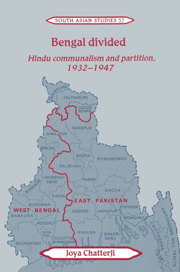Book contents
- Frontmatter
- Contents
- List of maps
- List of tables
- Acknowledgements
- List of abbreviations
- Glossary
- Map 1 Bengal districts
- Introduction
- 1 Bengal politics and the Communal Award
- 2 The emergence of the mofussil in Bengal politics
- 3 The reorientation of the Bengal Congress, 1937–45
- 4 The construction of bhadralok communal identity: culture and communalism in Bengal
- 5 Hindu unity and Muslim tyranny: aspects of Hindu bhadralok politics, 1936–47
- 6 The second partition of Bengal, 1945–47
- Conclusion
- Appendix
- Bibliography
- Index
- Cambridge South Asian Studies
4 - The construction of bhadralok communal identity: culture and communalism in Bengal
Published online by Cambridge University Press: 04 August 2010
- Frontmatter
- Contents
- List of maps
- List of tables
- Acknowledgements
- List of abbreviations
- Glossary
- Map 1 Bengal districts
- Introduction
- 1 Bengal politics and the Communal Award
- 2 The emergence of the mofussil in Bengal politics
- 3 The reorientation of the Bengal Congress, 1937–45
- 4 The construction of bhadralok communal identity: culture and communalism in Bengal
- 5 Hindu unity and Muslim tyranny: aspects of Hindu bhadralok politics, 1936–47
- 6 The second partition of Bengal, 1945–47
- Conclusion
- Appendix
- Bibliography
- Index
- Cambridge South Asian Studies
Summary
Questions of ‘identity’ have not traditionally been the subject matter of historians. They have generally been viewed as belonging to a sphere far too ambiguous to be studied using the conventional tools of historical method. But recent trends in the social sciences – in particular the critique of empiricism and the growing acceptability of interdisciplinary and interpretative approaches – have encouraged historians to venture into this territory. Social anthropology, hermeneutics, linguistics and literary theory in particular have provided conceptual tools with which they have analysed the sacred and symbolic spheres around which communal identities have been forged.
It is possible to outline, with the help of these resources, the emergence of a bhadralok Hindu communal identity in Bengal in the early decades of this century. This has not been attempted before, not least because this identity has not been immediately visible to historians. There are at least two reasons for this. The first is that studies of communalism in India have tended to have Partition as their point of reference. Because Partition is widely believed to have been the outcome of a Muslim separatist movement, such studies have focused primarily on the emergence of Muslim separatism and Muslim communal identities. In the case of Bengal, this has led to the common assumption that the Muslims of Bengal were inherently communal and separatist, and that their communal sentiments could be mobilised at will by ‘elite’ leaders for their own ends.
- Type
- Chapter
- Information
- Bengal DividedHindu Communalism and Partition, 1932–1947, pp. 150 - 190Publisher: Cambridge University PressPrint publication year: 1994
- 1
- Cited by



